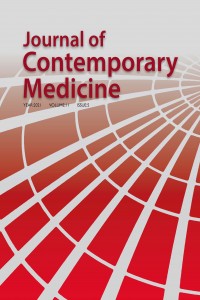Öz
Kaynakça
- 1. Hess EP, Wyatt KD, Kharbanda AB, et al. Effectiveness of the head CT choice decisionaid in parents of children with minör head trauma: study protocol for a multicenter randomized trial .Trials. 2014;15:253.
- 2. Larson DB, Johnson LW, Schnell BM, et al. Risinguse of CT in child visit stothe emergency department in the United States, 1995–2008. Radiology. 2011;259:793–801.
- 3. Bozan Ö, Aksel G, Kahraman HA, et al. Comparison of PECARN and CATCH clinical decisionrules in children with minör blunt head trauma. Eur J Trauma Emerg Surg. 2019;45:849-855.
Öz
Aim: We aimed to identify patients admitted to pediatric emergency service due to head trauma using clinical decision-making rules.
Methods: This is a prospective cohort study involving who referred to a tertiary university hospital pediatric emergency service due to minor head trauma. Evaluations were made with PECARN, CATCH and CHALICE clinical decision rules.
Results: 326 cases were included in the study. 63.5% (207) of the cases were male, and their ages were 52±52 months (min: 1 day - max: 214 months). 61.9% (202) of the cases were admitted due to a fall. 15.3% (49) cases presenting with minör head trauma had a (computize tomography)CT performed. In cases under the age of three months the CT scan rate was 66.6%, while it was 11% in cases over three months. 50% of the cases who had a CT scan satisfied the clinical decision rules. However, two cases who had traumatic brain injury(TBI) in the CT could not be determined with clinical decision rules. There was a statistically significant correlation between the presence of severe mechanism of injury and TBI findings in the CT(p<0,05).
Conclusions: In the CT decision for patients who were admitted with minor head trauma, the role of clinical decision rules is note worthy. In addition, physician experience, the physicians’ knowledge of clinical decision rules, the awareness of/raising awareness to the families about the harms of CT and the necessary conditions being provided by hospital observation units for the patients are also essential.
Anahtar Kelimeler
Kaynakça
- 1. Hess EP, Wyatt KD, Kharbanda AB, et al. Effectiveness of the head CT choice decisionaid in parents of children with minör head trauma: study protocol for a multicenter randomized trial .Trials. 2014;15:253.
- 2. Larson DB, Johnson LW, Schnell BM, et al. Risinguse of CT in child visit stothe emergency department in the United States, 1995–2008. Radiology. 2011;259:793–801.
- 3. Bozan Ö, Aksel G, Kahraman HA, et al. Comparison of PECARN and CATCH clinical decisionrules in children with minör blunt head trauma. Eur J Trauma Emerg Surg. 2019;45:849-855.
Ayrıntılar
| Birincil Dil | İngilizce |
|---|---|
| Konular | Sağlık Kurumları Yönetimi |
| Bölüm | Orjinal Araştırma |
| Yazarlar | |
| Yayımlanma Tarihi | 17 Eylül 2021 |
| Kabul Tarihi | 27 Ağustos 2021 |
| Yayımlandığı Sayı | Yıl 2021 Cilt: 11 Sayı: 5 |


